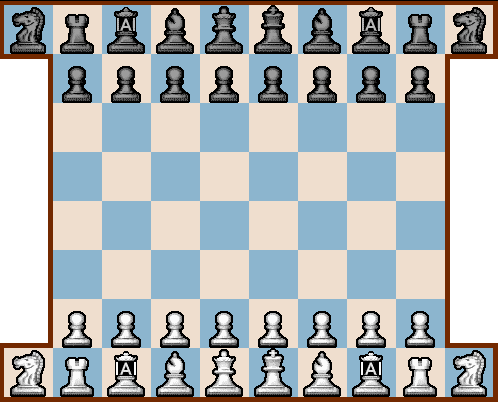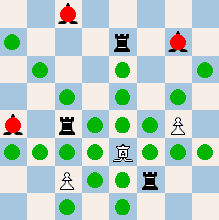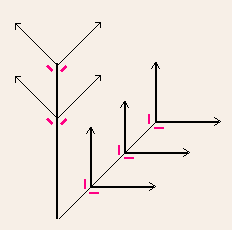

The Amiral is a bifurcation piece. It slides like a queen. It can make a capture by performing a move in two legs, by changing from orthogonal to diagonal, or vice versa. In case of a diagonal move, it can make a capture by bouncing orthogonally on a piece of any colour positioned to the side of the diagonal, and land on an enemy piece somewhere on the orthogonal, provided that any intermediate squares are empty. The capture move is performed in the prolonged movement direction only (two direction alternatives). While the Amiral slides along a diagonal, several orthogonals (in the prolonged movement direction) could be chosen, provided that there exist screens for bouncing. In case of an orthogonal move, it can initiate capture on a diagonal. It functions similarly as described. The Amiral's value is 5, that is, the same as a rook (preliminary estimate). Other rules are the same as in standard chess, except for the possible promotion to Amiral.
One would expect this piece to lose power when screens for bouncing become fewer in the endgame. However, it appears that it cooperates finely with friendly pieces. For instance, the king may advance and position himself so that the Amiral can bounce on him, thereby causing threats. Hence this piece, unlike its cannon relatives, retains its value in the endgame. It is a highly cooperative piece, something which makes it interesting for the positional player. "Amiral" is a suitable name for this piece, since its movement is reminiscent of a sailing warship. It cruises between the pieces. In order to attack it needs wind in the stern. Amiral Chess, and the new Amiral piece, were invented by undersigned, September 2006.
Amiral [Arab 'lord of the (sea)'] a : flag officer b : a commissioned officer in the navy or coast guard who ranks above a vice admiral and whose insignia is four stars c (archaic) : flagship.
 The Amiral can move in two legs, the first is a queen slide and the second is an orthogonal or diagonal bounce-capture, which is optional (red = capture).
The Amiral can move in two legs, the first is a queen slide and the second is an orthogonal or diagonal bounce-capture, which is optional (red = capture).
 The Amiral's capture principle. In any of its eight movement directions, there could be many screens to choose from. The screens, that are used for bouncing, occur anywhere on the first leg.
The Amiral's capture principle. In any of its eight movement directions, there could be many screens to choose from. The screens, that are used for bouncing, occur anywhere on the first leg.
• You can download my free Amiral Chess program here (updated 2007-07-10), but you must own the software Zillions of Games to be able to run it (I recommend the download version).
• Don't miss my other chess variants.
© M. Winther (September 2006).